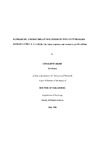Patriarchy and discordant discourses in the contemporary Roman Catholic Church : the voices of priests and women in parish settings
| dc.contributor.supervisor | Chandler, Joan | |
| dc.contributor.author | Sharp, Geraldine | |
| dc.contributor.other | School of Society and Culture | en_US |
| dc.date.accessioned | 2011-05-11T08:35:10Z | |
| dc.date.available | 2011-05-11T08:35:10Z | |
| dc.date.issued | 1998 | |
| dc.identifier | Not available | en_US |
| dc.identifier.uri | http://hdl.handle.net/10026.1/357 | |
| dc.description.abstract |
This thesis explores the sexual theology and contemporary teachings of the Roman Catholic Church and considers their implications for women and priests. It examines the salience and relevance of traditional teaching in the everyday lives of priests and women. It questions the link between a traditionally formed priesthood and the customary beliefs and practices of 'ordinary' English Catholics. Feminist scholarship has produced powerful insights into the ways in which organised religion has subordinated women through patriarchal structures and organisation, although there has been little exploration of the gendered nature of Catholic sexual theology. This thesis suggests that the negative construction of women's bodies in sexual theology, underpins the continued subordination of women in the Catholic Church. It argues that religious inscriptions on women's bodies are central to the continued control of women Al a patriarchal Church. This thesis uses patriarchy, sexual theology, and power and authority, as the main themes of discussion. An examination of the discourses of traditional sexual theology and contemporary teaching reveals that patriarchal inscriptions on women's bodies are central to each of these themes and they are mutually supportive and sustaining. Sociological research has demonstrated a disjuncture between contemporary teaching and the beliefs and practices of 'ordinary' English Catholics. This thesis adds a gender dimension by suggesting that the English parish is a place of contradictions in which differing attitudes towards women are a significant factor. It also examines the links between contemporary teaching and the beliefs and practices of English Catholic priests and women. The evidence suggests that traditional sexual theology has little relevance in the everyday lives of English Catholic priests and women. There is a lack of `fit' between the traditional teaching of the Church and social experience. Nevertheless patriarchal ideas and beliefs continue to exist and have value, both in contemporary teaching and in the day-to-day life of the parish, and contribute to the contradictions and conflict of contemporary parish life. The discourses of English Catholic the priests and women in this study suggest, that both have been affected not only by the dominant discourse of the Church , but also by the critical discourses of the surrounding world. Views of women are emerging, which are in contrast to the negative view of women in Catholic sexual theology. The discourses of women and priests have much in common with each other but little in common with either traditional sexual theology or the teaching of the current pope. Together these discourses represent a significant point of resistance to the negative view of women in Catholic sexual theology and to traditional power and authority in the Catholic Church. A 'customary Priesthood' with an affinity to the 'customary Catholicism' of English Catholics appears to be emerging. This calls to question the legitimacy of traditional teaching and papal authority. | en_US |
| dc.language.iso | en | en_US |
| dc.publisher | University of Plymouth | en_US |
| dc.title | Patriarchy and discordant discourses in the contemporary Roman Catholic Church : the voices of priests and women in parish settings | en_US |
| dc.type | Thesis | |
| dc.identifier.doi | http://dx.doi.org/10.24382/3958 | |
| dc.identifier.doi | http://dx.doi.org/10.24382/3958 |
Files in this item
This item appears in the following Collection(s)
-
01 Research Theses Main Collection
Research Theses Main


